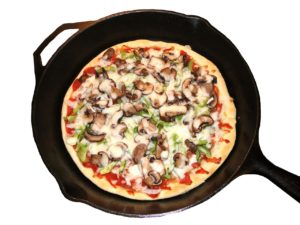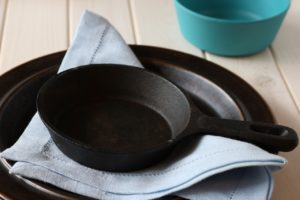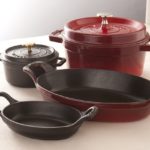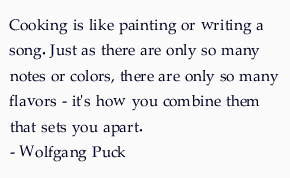So, the question then is how to season a cast iron pan? The easiest is to use an oven. But if you don’t have one at home, you can always do it using a stove. For now, let’s take a look of how to season a cast iron pan using an oven first.
How To Season A Cast Iron Pan Using Oven
 When you first bring home a new cast iron pan, wash it with warm soapy water. Do the same for an old pan that you need to re-condition. Use a scrub pad and get rid of all the gunk and rust that have accumulated. You can also use coarse salt for cleaning out the gunk. Wash both the inside and outside of the pan. Then, dry it completely with a towel.
When you first bring home a new cast iron pan, wash it with warm soapy water. Do the same for an old pan that you need to re-condition. Use a scrub pad and get rid of all the gunk and rust that have accumulated. You can also use coarse salt for cleaning out the gunk. Wash both the inside and outside of the pan. Then, dry it completely with a towel.
Next, get some solid shortening such as Crisco. Solid shortening is better than oil because it doesn’t leave a sticky surface compared to using certain liquid oil. However, different people do use different types of oil to season their pans. But if you are planning to use oil, the recommendation is to use one with a high smoke point like peanut oil.
Then, grab some paper towels and dab a generous amount of shortening onto the pan. Spread the shortening all over with the paper towel including the exterior.
Preheat the oven to 350°F and dump your cast iron pan inside. Put it upside down and line the oven with a drip pan underneath to catch any drips. Let it sit in the oven for an hour. After that, switch the oven off and let the pan to cool in the oven before taking it out.
Once that is done, you will then have a seasoned cast iron pan. You can rub another layer of shortening onto the pan before cooking. Some people like to start the cooking process with bacon, fried chicken or other high fat content food to continue the seasoning process, especially when the pan is still new. This will add to the layer of non stickiness if you don’t have an inherited pan that from your old folks that has seen years of use.
How To Season A Cast Iron Pan Using Stove
Using the stove to season a cast iron pan is much quicker. But the basics behind it is the same. Firstly, wash the pan like mentioned above using coarse salt or hot soapy water. Then, dry it with a towel.
Put it on high heat on the stove to let the pan dry completely. When you heat up the pan, it will also open up the pores. Once you have heated up the pan for a 3 to 4 minutes, turn off the stove and add in shortening or oil onto the pan. Spread it all around using a paper towel.
Put it back on the stove and turn back on the heat to medium. Let it sit on the stove and wipe off excess oil with a paper towel occasionally. What you want is a very thin layer covering the surface and not let excess oil cake up and turn sticky. After a few minutes, the oil will start to smoke. How soon that happens will depend on the type of oil and heat level that you use. Some people will let it smoke for half a minute or more before turning off the stove.
Another way of doing it is to let the pan sit on high heat for a while before adding the oil and wiping it around. Continuing spreading the oil and polishing the surface with a paper towel until it gets dry. It will smoke very quickly because of the high heat. Remove it after 15 seconds or so and let it cool before repeating the process. Do it a few times and you will get a seasoned pan thereafter.
Should You Season Your Pan With The Oven Or Stove?
Both  the oven and stove work to get you pan nicely seasoned. The reason why you would choose to use the stove although it takes longer is because it will give you a more uniform layer of non stick. It is also better at resisting corrosion.
the oven and stove work to get you pan nicely seasoned. The reason why you would choose to use the stove although it takes longer is because it will give you a more uniform layer of non stick. It is also better at resisting corrosion.
Using the stove is quick, but the layer of seasoning may be patchy. You can get the non stick effect by using the stove to season your cast iron pan and that is why many people are contented using this method. But using the oven is best to give you longer lasting performance and fewer maintenance in between.
Can You Wash Your Cast Iron Pan?
Many people don’t wash their cast iron cookware. They will just wipe it off with a paper towel. That is good enough if the pan is relatively clean after cooking.
However, if you really need to wash it to get rid of food residues, use only hot water. Unless it is new or you need to remove gunk to re-season an old pan, you don’t need to use soap for your cast iron pan. This is because you want to keep the layer of seasoning intact as much as possible. So, just use hot water and a wooden brush with a handle to scrap off the food scraps.
The bottomline is you can wash your cast iron pan but towel dry it completely immediately after washing. To be on the safe side, you can also heat it up on the stove to make sure it is completely dry before you store it away. If your pan comes with a lid, it is also advisable to not to close it up when storing. A closed up pan may trap moisture and cause it to rust.
A cast iron pan certainly needs proper care. You can’t leave it soaking in the sink or drying on its own after washing unlike ceramic cookware and other types of non stick pots and pans. You might also need to re-season it from time to time when it has accumulated gunk. But a cast iron skillet like Lodge is highly affordable and durable. It is also free of toxic elements unlike Teflon pans and can go from the stove to the oven without damaging the cooking surface.



 0
0 



Speak Your Mind